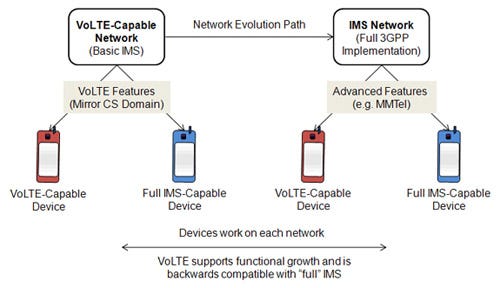January 26, 2011

It is clear now – if there ever was any real doubt – that IP Multimedia Subsystem (IMS) is the preferred choice of mobile operators to support voice service in LTE networks, and specifically that the IMS-lite "VoLTE" mechanism will be the first step toward actually implementing it.
Yes, there is irony in the fact that plain old voice telephony is the application that looks set to pull through IMS into broad usage within mobile networks. And yes, circuit-switch fallback and dual-radio devices will serve as useful interim mechanisms for some operators. But in the context of a ten-year LTE planning horizon, the transition to IMS-based call control is desirable, achievable and more efficient than stopgap alternatives.
What's interesting, and also more debatable, is the extent to which VoLTE could set the stage for a more fundamental transition to operator-provided real-time, rich-media services. This is one of the themes discussed in my recent Heavy Reading report, "Voice Over LTE, IMS & the Future of Rich-Media Services in the 4G Era."
A strength of the GSM Association (GSMA) -backed "VoLTE Initiative" is that it provides a simple set of features intended to be reasonably straightforward to implement. The industry now has guidance on use cases, service features, roaming interfaces, and so on, such that it should be possible to at least match the service capability of the existing circuit-switched domain used in 2G and 3G networks.
That is nice to have, but not compelling. A core tenet of the initiative, therefore, is for VoLTE to serve as the starting point for a more complete 3rd Generation Partnership Project (3GPP) IMS implementation capable of supporting a richer service set, as and when operators want to pursue this evolution path. Forward and backward capability between VoLTE and full IMS is what makes this possible. A VoLTE device, as shown below, can operate on a network running full 3GPP IMS, and a 3GPP IMS-compatible device can run on a network that supports VoLTE only.
This is, theoretically, very powerful. Operators can introduce VoLTE without having to fully implement IMS, and then evolve the network over time as end-user requirements and demand for rich media become clearer and as technology matures. Similarly, handset makers can create devices that support 3GPP Release 8 and Release 9 functions that work with a VoLTE network and are also prepared for network and service evolution.
If you believe that IMS is the answer for "call control" in all IP mobile networks (there's no real alternative), then VoLTE is the logical starting point. Even if you have doubts about IMS over the long term, VoLTE provides a practical solution that – although challenging to implement in some aspects (e.g., handover between LTE and 2G/3G) – should be a deployable solution for most reasonably advanced operators.
Can operators reinvent and extend the voice model into billable rich media services? I think it's too early to say, but at least with this approach, the potential is there and investment won't be sunk into interim measures that close off that route to innovation.
— Gabriel Brown, Senior Analyst, Heavy Reading
For more information about Heavy Reading's "Voice Over LTE, IMS & the Future of Rich-Media Services in the 4G Era," or to request a free executive summary of this report, please contact:
Dave Williams
Sales Director, Heavy Reading
858-485-8870
[email protected]
Read more about:
OmdiaYou May Also Like









